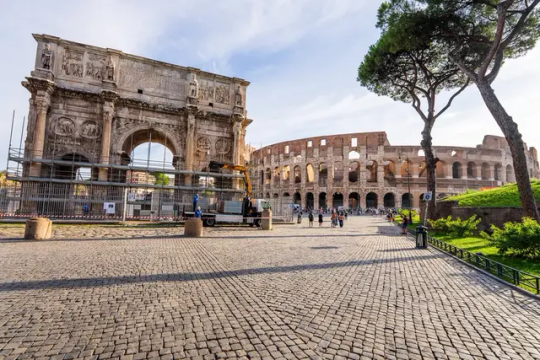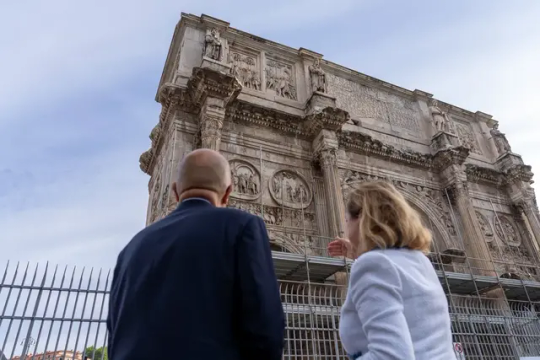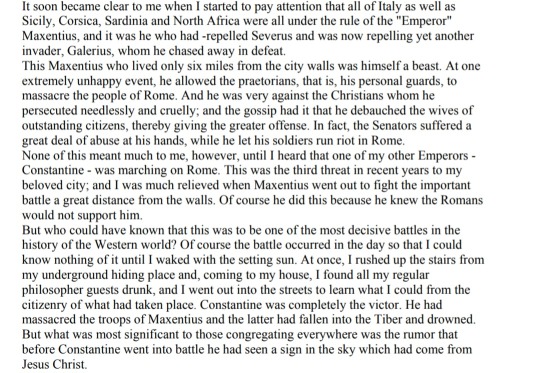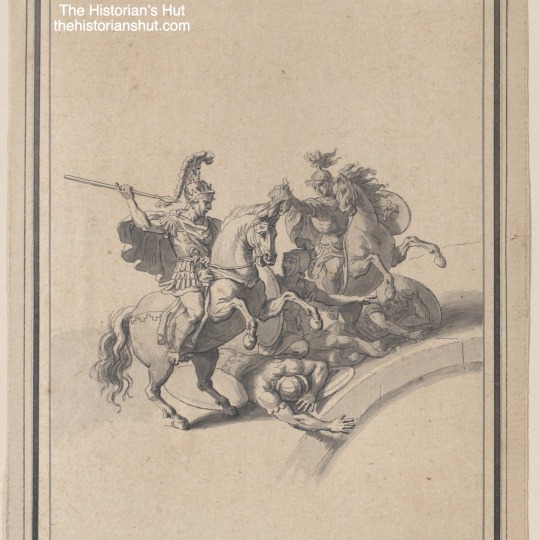#milvian
Explore tagged Tumblr posts
Photo

The Battle of Milvian Bridge, Victory of Constantine over Maxentius by Nicolas Tournier
Oil on canvas, Musee des Augustins, Toulouse, France
#Nicolas Tournier#fineart#art#painting#artwork#masterpiece#fineartprint#gallery#museum#battle#milvian#victory#constantine#maxentus#tournier#horse#fight#oil on canvas#oil painting#musee des augustins#musee#france
7 notes
·
View notes
Text
there's this really annoying phenomenon i've noticed in semi-popular histories using really unreliable ancient sources that i'll need to make up an extreme example for -
"it's unlikely, that, as Procopius tells us, Theodora was wearing a green robe when her headless body roamed the halls of the palace at night, since she famously supported the Blue arena team."
we're questioning the details of an account, which is good, but often it's the minutiae of a larger narrative that in itself seems fairly implausible. and i get it, these sources are fun & there's often not a second story to compare them to to try to get closer to things that actually happened, but i do wonder how much actual value there is in shuffling these details around while not really interrogating that larger story.
eta: people who do this aren't differentiating between "this is present" and "this is relevant" - there are certainly situations in which it matters what color shirt someone was wearing but for the most part "correcting" a detail like that doesn't change enough about the larger point to be worthwhile.
#i forget who it was who spent at least a couple of pages 'proving'#that constantine really could have had the 'in this sign conquer' dream#and like. yeah he could have. people have dreams all the time#did he have a dream about a cross and did jesus help him win the battle of the milvian bridge are different questions#on writing history
36 notes
·
View notes
Text

This image depicts the imperial scepter of Roman Emperor Maxentius (r. 306-312 CE), a significant historical artifact. It is notable as the only surviving imperial scepter from ancient Rome. The scepter, topped with a crystal sphere, was discovered in 2006 near the Palatine Hill in Rome, alongside several imperial banners.
The Palatine Hill was an important site in ancient Rome, often associated with imperial power, and the discovery of these objects adds important archaeological insight into the symbolism and authority of Roman emperors. Maxentius was a notable figure, remembered for his rivalry with Constantine the Great, which culminated in the famous Battle of the Milvian Bridge in 312 CE.
#light academia#dark academia#classical#academia aesthetic#escapism#academia#books and libraries#classic literature#books#architecture#object#imperial#scepter#roman#emperor#Maxentius#4th century#rome#Palatine Hill#Constantine#Battle of the Milvian Bridge#archaeology#archeological#aesthetic#royal core#cottage core#academics#mood#vibe#tumblr
33 notes
·
View notes
Text
Who was Valentine and why February 14 is "Valentine's Day"
Valentine was a Roman physician who converted to Christianity and became a priest. He performed marriages for soldiers, despite the fact that the emperor forbade it, as he considered it incompatible with a military career. Valentine then began to perform secret marriages for couples in love. When he was discovered, Emperor ordered his arrest. In prison he was tortured for refusing to renounce his faith and beheaded on 14 February 269.
He is commemorated on February 14 in the Roman Martyrology, which remembers him only as a martyr: "At Rome, on the Via Flaminia, near the Milvian Bridge, Saint Valentine, martyr."

Relic of St. Valentine in the church of Santa Maria in Cosmedin, Rome, Italy. Photo: Dnalor 01 , CC BY-SA 3.0 AT , vía Wikimedia Commons
149 notes
·
View notes
Text

Rome’s Ancient Arch of Constantine Struck by Lightening
During a storm on September 3, lightning struck Rome’s Arch of Constantine, chipping the structure’s marble surface. The 1,700-year-old arch and its neighbor, the Colosseum, were two of several sites affected by the thunderstorm, which produced 2.36 inches of rain in less than an hour. Usually, the city sees a similar amount over the entire month of September.
“A lightning strike hit the arch right here and then hit the corner,” a tourist at the site told Reuters’ Alberto Lingria. “We saw this fly off,” the tourist added while pointing to a fallen block of stone.
Finished in 315 C.E., the Arch of Constantine is one of Rome’s three surviving ancient triumphal arches, each erected to honor a person or event. This arch commemorates Constantine I’s 312 victory over the emperor Maxentius. That same year, Constantine devoted himself to Christianity—the first Roman ruler to do so.

The fierce storm also felled two large trees near the Circus Maximus, flooded the Trevi Fountain and flooded the Colosseum’s subterranean tunnels, reports CNN. After lightning struck the arch, staff of the Colosseum Archaeological Park quickly gathered its dislodged pieces and placed them in a secure location, according to a statement from Italy’s Ministry of Culture.
In the days that followed, some tourists stumbled upon additional pieces on the ground.
“My American group found these fragments, and we’re handing them over to the workmen,” tour guide Serena Giuliani told the London Times’ Tom Kington on the morning of September 4.
Specialists are now examining the condition of the fragments. Officials say the damage was limited to the monument’s southern side, where unrelated restoration work had started just days earlier, allowing for quick repairs.


At roughly 70 feet tall and 85 feet wide, the Arch of Constantine contains three separate arches, each framed by columns. The intricately decorated structure is adorned with recycled fragments, or spolia, taken from other ancient buildings, including monuments honoring Trajan, Hadrian and Marcus Aurelius.
The arch is also decorated with carvings of Constantine, including a series of reliefs depicting his victorious fight against Maxentius in the Battle of the Milvian Bridge.
In 306, Constantine was leading Roman troops in Britain—then part of the Roman Empire—when his military declared him their emperor. His brother-in-law, Maxentius, also declared himself the emperor around the same time. After years of complex power struggles, the two rulers ultimately faced off in 312 at Rome’s Milvian Bridge, which overlooks the river Tiber. Panels on the Arch of Constantine depict the battle’s conclusion, showing Maxentius’ troops drowning in the river.
The arch’s recent encounter with lightning may have carried spiritual significance for its ancient builders, as “the bolts were believed to be the work of the gods,” per the Times. These spots were sacred for the Romans, who sometimes erected temples at such sites.
By Sonja Anderson.

#Rome’s Ancient Arch of Constantine Struck by Lightening#Rome’s Arch of Constantine#emperor Maxentius#emperor constantine#ancient artifacts#archeology#archeolgst#history#history news#ancient history#ancient culture#ancient civilizations#ancient rome#roman history#roman empire#roman art#ancient art#art history
207 notes
·
View notes
Text

Bronze follis (20 mm; 3.73 g) of the Roman emperor Constantine I "the Great" (r. 306-337 CE), minted at Aquileia, 316-17. On the obverse is the laureate bust of Constantine. On the reverse is the sun god Sol, shown with his usual radiant crown and holding a globe.
At the time this coin was struck, Constantine was master of the western half of the Empire, having defeated his rival Maxentius at the Battle of the Milvian Bridge (312). The following year, he and the Eastern emperor Licinius had jointly issued the Edict of Milan, which provided for religious toleration and ended official persecution of Christianity, now a "permitted religion" (religio licita), in their domains. This coin, however, shows no obvious signs of the changing religious landscape. Sol, in his manifestation as the Unconquered Sun (Sol Invictus), was widely popular in cult and had been the patron deity of the earlier emperor Aurelian, who styled himself "Restorer of the World" (Restitutor Orbis). It is possible that Constantine, whatever his personal religious leanings after the Milvian Bridge, thought it politically savvy to retain traditional solar imagery on his coinage so as not to alienate his pagan subjects. Another possibility, not incompatible with the first, is that Constantine identified the Christian God with Sol, both being understood as all-seeing, all-powerful deities who favored his cause and furnished victory in battle.
Photo credit: Classical Numismatic Group, Inc. http://www.cngcoins.com | Creative Commons Attribution-Share Alike 2.5 Generic
#classics#tagamemnon#history#ancient history#Ancient Rome#Roman Empire#Roman history#Constantine I#Constantine the Great#art#art history#ancient art#Roman art#Ancient Roman art#Roman Imperial art#late antiquity#late antique art#coins#ancient coins#Roman coins#Ancient Roman coins#numismatics#ancient numismatics#Roman numismatics#follis
33 notes
·
View notes
Text


Details of the Arch of Constantine, Rome, erected in 315 to commemorate the victory of Constantine I the Great at the Battle of the Milvian Bridge (28 October 312) against Maxentius. It was the last triumphal arch built in Rome during antiquity.
67 notes
·
View notes
Photo

This map illustrates Constantine I's (also known as Constantine the Great, c.272 - 337) rise to power, beginning with his proclamation as emperor by his troops in 306 CE and solidified through key military victories, including the Battle of the Milvian Bridge in 312 CE, which led to his conversion to Christianity. By 324 CE, he became the sole ruler of the Roman Empire after defeating Licinius...
41 notes
·
View notes
Text

meme about a steampunk worldbuilding project of mine (explanation under cut)
Real life lore: Roman Emperor Constantine the First was supposedly the first Roman Emperor to be a Christian, and according to his biography by Eusebius of Caesarea, Constantine converted to Christianity after receiving a vision on October 27, 312 AD, during the Battle of the Milvian Bridge. He (as well as his soldiers) saw a glowing Christian cross in the sky, and above it, were the Greek words Ἐν Τούτῳ Νίκα, "By this sign, you shall conquer". Constantine had the image of the cross painted onto his soldier's shields, won the battle, and returned to Rome, attributing his success to the strength of the Christian God. This paved the way towards the larger Christianization of the Roman Empire.
My world Lore: Constantine was oh so sleepy that day that he took a little nappy-nap 😴, he never saw the vision of the cross, he never converted to Christianity, he won the battle anyways, and returned to Rome. The Christianization of the Roman Empire took much longer, and social attitudes took longer to change as well. The practice of damnatio ad bestias (having people killed by wild animals) was not abolished in Rome in 681 AD, but instead was allowed to continue for several centuries longer before slowly dwindling out of popularity.
In those several centuries, the lions used in the gladiatorial arenas started to reproduce, and adapted to life in the network of underground tunnels and hallways underneath of the arena. The Romans selectively bred them for their ferocity, to create a better spectacle. Resulting in a population of lions that have been bred to prowl about in underground tunnels and to view humans as food (to be messily devoured).
Much like in the real world, in 1235, Holy Roman Emperor Frederick II gifted lions to King Henry III of England, which were sourced from populations under the arena. These lions were kept in the royal menagerie at the Tower of London, but unfortunately, some escaped into the surrounding countryside. They lived in caves and abondoned mines before eventually moving back into London proper when the sewer system was completed in 1875. They lurk in the sewers and mostly attack street urchins.
#my musings#worldbuilding#alt history#alternate history#unnamed steampunk worldbuilding project#roman empire#christianity#world history
2 notes
·
View notes
Note
Have you read TVA and Blood and Gold? I would LOVE your rundown on all the historical inaccuracies in BaG.
Unfortunately yes, I have read those with my eyes :/
(the Marius/Armand pederasty conversation I've been meaning to have for like a year below the cut btw)
I wish I hadn't read B&G so young, I didn't have the breadth of knowledge or the foresight to mark anything for later when I was sixteen. I'd reread it for this exact analysis but really I don't think I have it in me so memory and ctrl + f to confirm will have to suffice.
Honestly, the biggest problem I had with it wasn't inaccuracies so much as the fact that the whole book reads like a Wikipedia entry. It's so clumsy and dry, it feels like AR just wants us to know how many Roman Facts she learned. It overshadows the story rather than adds to it. Literally read this (if you can stand it).

There was not one reason in the world that she needed to explain the Battle of the Milvian Bridge in that level of detail, and that's coming from me. This sounds like a bad undergrad paper from a student who wants to prove they did the reading.
The whole book feels like this except when it detours into creepy and pedophilic, and I just don't need my vampire book to explain the Council of Nicaea AND the Edict of Milan AND the Parthian Wars AND the Vatican wall frescoes AND the Medici bank and a million other things to me like I'm in a survey lecture. It's mind-numbing for me and this is literally what I DO, so I can only imagine how other people must feel with no context or particular interest in this stuff.
It's not that she's WRONG per say, it's more that she clearly has no understanding of these subjects outside the rote recitation of facts. It's just regurgitated bullet points about Roman history and the Italian Renaissance. She also repeats some well known apocryphal stories in there, but I'm going to be generous and hope she doesn't think these are facts (like the Chi-Rho epiphany).
If anything seems suspicious and I don't remember it though, feel free to send it to me and I can yay or nay the information to the best of my ability!
*cw here for discussion of CSA*
With that said, I do think AR had a very skewed understanding of the pederastic dynamic or was choosing to ignore it, which is unfortunate considering how attached she was to the idea. A lot of my thesis research coincided with Greco-Roman pederastic tradition, so it's a pet peeve of mine when it's misapplied. It's not an uncommon problem (Call Me By Your Name has this going on too), but authors sending gay relationships with a rapey age gap through a "pederasty" funnel always pisses me off.
The history of pederasty is very long and complicated and ancient (we're talking Homer and Iliad kind of old here), but the bare bones explanation of the process and logic is this:
The ancient Greeks were deeply invested in turning their upper class boys into good citizens. To accomplish this, sometimes an established adult man would woo a younger male (most often starting at 14-19 years old) with gifts and attention over an extended period of time. Once the courtship was complete and the boy's self control had been proven, there were sexual relations between the two for a period of time.
The purpose of this relationship was ultimately to educate the boy, and the physical pleasure was used as a teaching tool to establish rapport and intimacy that could then be escalated to instruction on matters of philosophy and intellect in general. Essentially using the mastery and maturation of one's body as a stepping stone to the mastery and maturation of the mind. Once the boy was appropriately prepared to enter elite male society and/or had become physically developed as a man, the relationship ended.
It's pretty obvious that she's trying to do a whole pederastic erastes/eromenos thing with Marius and Armand, but she took an already very bad and gross practice from history and muddled it up with her own awful ideas about consent from minors and sexual fantasies of a kinky student/teacher savior relationship in her vampire books.
I hate the erotic and romanticized version of pederasty that's become weirdly popular in gay media, and AR was one of the first to really do this. It just picks up the historical thread of CSA under the guise of a kid's "consent" and continues to normalize it to modern readers with a new sexy twist. Using a bastardized version of a fucked up ancient practice to implicitly justify or downplay the severity of statutory rape is simply not the move, especially when gay and bisexual men already face stigma around being predatory and pedophilic.
#related: i hate when authors are ALWAYS super specific about location stuff it drives me crazy and ar does it so much in b&g#we don't need to know that marius is at san paolino and took via nuova and visited a palace on the coelian hill#we get it you read some travel guides#for the love of god pick one or two that are actually relevant#answered#vc
20 notes
·
View notes
Text

Bernard Picart (1673–1733) based this vignette study on work by Charles Le Brun (1619–1690). Their artworks depict fighting that occurred at the Battle of Milvian Bridge, where Constantine (r. 306-337) defeated Maxentius (r. 306-312). Read more about the art and history, here.
#history#books and reading#world history#books#ancient history#ancient rome#romans#roman empire#rome#constantine#ancient art#art#artwork#art history#drawing#drawings#illustration
1 note
·
View note
Text
In 310 Constantine had a vision in one of the sanctuaries of Apollo in Gaul, perhaps at Grand, m the Vosges. The Sun God appeared to him, accompanied by Victory, presenting him with laurel crowns on each of which was inscribed the sign for the number thirty-three X's thus promising a life and reign of exceptional length
...
Constantine captured Maximian in Marseilles and had him put to death (or forced to commit suicide) in May 311 He then sought the support of the Christians against his rival, Maxentius, Maximian's son, who was defeated and killed on October 28, 312, at the battle near the Milvian bridge, at the gates of Rome. Like Apollo in 310, the god of the Christians sent him, before the battle, a sign of his favor. Two divergent and equally authoritative accounts of the precise nature of this apparition have come down to us from two of the emperor's associates, Lactantius and Eusebius.
Lactantius wrote On the Death of the Persecutors (meaning those emperors who persecuted Christians) in the West in 314-315, not long after the actual event. He placed the vision at night, just before the battle at the Milvian bridge . Lactantius more than likely heard about this from Constantine him self, with whom he was already in favor. (Before 317 he was named tutor in Latin literature to the emperor's elder son, Crispus.) In the dream Constantine was instructed to place on his soldiers' shields the monogram of Christ.
The second witness, Eusebius, wrote only after Constantine's death (337), but he had met him several times and claimed to be relating personal confidences. The emperor, on his way to overthrow Maxentius but perhaps still in Gaul, is said to have seen in the sky, just past midday, the glowing sign of the cross with the inscription "Conquer with this" (rendered in Greek by Eusebius). The next night a dream told him to use this sign for protection. This account contains the same elements as the Apollonian vision: the sun, X's or a cross, victory. It is explained by a dream that reminds us vividly of the dream before the battle of the Milvian bridge, which led Constantine to use Christ's monogram as a military insignia. This might be considered a reinterpretation of the Apollonian miracle and the Christian dream, combining their virtues in a unique episode. Such an arrangement could have been devised by the emperor himself, not necessarily as a trick, when, near the end of his life, he had completely renounced his devotion to the Sun
-Chuvin, A Chronicle of the Last Pagans
Constantine pulled the old "i had a dream where god promised me stuff" trick twice in two years. bit tacky
16 notes
·
View notes
Text
Holidays 10.28
Holidays
Bhai Dooj (India)
Bhai Tika (Nepal)
Children’s Day (Australia)
Chucks-N-Pearls Day
Civil Servants’ Day (Brazil)
Common Fig Day (French Republic)
Cox Plate Day (Australia)
Day of International Concern About Young People and Gun Violence
Engineer’s Day (Venezuela)
Flying Baby Day
Folly Day
Gone-ta-Pott Day [every 28th]
Hari Sumpah Pemuda (Youth Pledge Day; Indonesia)
Honoring the Nation’s First Responders Day
International Animation Day
International Creole Day
Liberation of Ukraine from Nazi Invaders Day (Ukraine)
Milvian Bridge Day
National Caroline Day
National Comprehensive Sex Education Call-In Day
National Cry Yourself to Sleep Day
National Day of Outrage
National First Responders Day
National I Love You Day
National Immigrants Day
National Internal Medicine Day
National Internment Commemoration Day (Canada)
National William Day
Ohi Day (a.k.a. Ochi! Day or Oxi Day; Cyprus, Greece)
Part Your Hair Crooked Just To See If Anyone Will Say Anything About It Day
Plush Animal Lover's Day
Prefectural Earthquake Disaster Prevention Day (Gifu, Japan)
Q Day
Republic Day Eve (Turkey)
Separation of Church and State Day
Stan Lee Day (Los Angeles)
Stargate Day
Statue of Liberty Day
Ticker-Tape Parade Day
Time Day
Twitter Emancipation Day
Ugly Pickup Truck Day
Vote Early Day
World Judo Day
World Tobacco Growers’ Day
Youth Pledge Day (Indonesia)
Food & Drink Celebrations
National Chocolate Day
Wild Foods Day
4th & Last Monday in October
African-American Cotton Pickers’ Day [4th Monday]
Bank Holiday (Ireland) [Last Monday]
Equality Day (Antarctica) [4th Monday]
Green Monday [Monday of Last Full Week]
International School Library Day [4th Monday]
Labour Day (New Zealand) [4th Monday]
La Saoire i mi Dheireadh Fomhair [Last Monday]
Meatless Monday [Last Monday of Each Month]
Meditation Monday [Every Monday]
Monday Musings [Every Monday]
Moody Monday [Last Monday of Each Month]
Motivation Monday [Every Monday]
October Bank Holiday (Ireland) [Last Monday]
School Library Day (Canada) [Last Monday]
Independence & Related Days
Bokonton (Declared; 2007) [unrecognized]
Czechoslovakia (Now the Czech Republic; from Austria-Hungary, 1918)
Erusia (Declared; 2008) [unrecognized]
Foundation Day (Davao Occidental, Philippines)
United Republics of Michigan (Declared; 2019) [unrecognized]
Weekly Holidays beginning October 28 (Last Week of October)
Hudson Valley Restaurant Week (Hudson Valley, New York) [thru 11.10]
Festivals Beginning October 28, 2024
American Indian Tourism Conference (Marksville, Louisiana) [thru 10.31]
Supply Side West (Las Vegas, Nevada) [thru 10.31]
TechCrunch Disrupt (San Francisco, California) [thru 10.30]
Tokyo International Film Festival (Tokyo, Japan) [thru 11.6]
Feast Days
Abdias of Babylon (Christian; Saint)
Abgar V of Edessa (Eastern Orthodox Church)
Ayad Akhtar (Writerism)
Eadsige (Christian; Saint)
Evelyn Waugh (Writerism)
Extra Kinky Day (Pastafarian)
Faro, Bishop of Meauz (Christian; Saint)
Feast of the Einherjar (Norse)
Feast of the Lord of Miracles (Peru)
Fidelis of Como (Roman Catholic Church)
Firmilian (Christian; Saint)
Francis Bacon (Artology)
Fyribod (a.k.a. Forebode; Norse beginning of Winter)
Godwin of Stavelot (Christian; Saint)
Gumby Day (Church of the SubGenius; Saint)
Isis/Osiris Mysteries I (Pagan)
Job of Pochayiv (repose) (Eastern Orthodox Church)
Jude Thaddeus (a.k.a. Jude the Apostle; Western Christianity)
Leibnitz (Positivist; Saint)
Lord of Miracles (Lima; Christian; Saint)
Makoshe’s Holiday (Honoring Mother Earth; Asatru/Pagan Slavic)
Michael Noakes (Artology)
Neot (Christian; Saint)
Paraskrevi of Iconium (Christian; Saint)
Simon the Zealot (a.k.a. Simon the Canaanite; Simon the Apostle; Western Christianity)
The Tortoise (Muppetism)
Lucky & Unlucky Days
Butsumetsu (仏滅 Japan) [Unlucky all day.]
Umu Limnu (Evil Day; Babylonian Calendar; 50 of 60)
Premieres
All Quiet on the Western Front (Film; 2022)
An Alpine Symphony, by Richard Strauss (Tone Poem; 1915)
Barking Dogs Don’t Fite (Fleischer/Famous Popeye Cartoon; 1949)
Because I Got High, by Afroman (Song; 2001)
Bee Movie (Animated Film; 2007)
Black Beauty (Hanna-Barbera Animated TV Special; 1978)
The Blue Danube (MGM Cartoon; 1939)
Breakfast at Tiffany’s, by Truman Capote (Novella; 1958)
Decade, by Neil Young (Compilation Album; 1977)
Decline and Fall, by Evelyn Waugh (Novel; 1928)
The Desperate Showers (George of the Jungle Cartoon; 1967) [#8]
Droopy (Tex Avery Droopy MGM Cartoon; 1955)
Educating Rita (Film; 1983)
The Futurological Congress: From the Memoirs of Ijon Tichy, by Stanisław Lem (Novel; 1971)
Gulliver’s Travels, by Jonathan Swift (Novel; 1726)
How Green Was My Valley (Film; 1941)
Inferno (Film; 2016)
Kiss Meets the Phantom of the Park (TV movie; 1978)
The Legend of Zorro (Film; 2005)
Man's Search for Meaning, by Viktor E. Frankl (Philosophical Book; 1959)
News of the World, by Queen (Album; 1978)
The Ones Who Walk Away from Omelas, by Ursula K. Le Guin (Short Story; 1973)
The Pet Store (Disney Cartoon; 1933)
Pinterest (Social Media App; 2009)
Pop ‘im Pop! (WB LT Cartoon; 1950)
Puss in Boots (Animated Film; 2011)
Pussy Willie (Oswald the Lucky Rabbit Cartoon; 1929)
Puttin’ On the Dog (Tom & Jerry Cartoon; 1944)
The Quail Hunt (Oswald the Lucky Rabbit Cartoon; 1935)
Richard Pryor … Here and Now (Stand-Up Comedy Film; 1983)
Rotten Hood (Super Chicken Cartoon; 1967) [#18
The Rum Diary (Film; 2011)
Stargate (Film; 1994)
String Along Pink (Pink Panther Cartoon; 1978)
Supermarket Pink (Pink Panther Cartoon; 1978)
Talking Book, by Stevie Wonder (Album; 1972)
Tinker Bell (Animated Film; 2008)
We Can’t Dance, by Genesis (Album; 1991)
Today’s Name Days
Judas, Simon, Thaddeus (Austria)
Juda, Šimun, Siniša, Tadej, Tadija (Croatia)
Státní Svátek (Czech Republic)
Judas, Simon (Denmark)
Siim, Siimo, Siimon, Siimu, Simmo, Simmu, Simun (Estonia)
Simo (Finland)
Jude, Simon (France)
Freddy, Simon (Germany)
Evniki, Vili (Greece)
Simon, Szimonetta (Hungary)
Giuda, Simone (Italy)
Antoņina, Ņina, Ninona, Zemgals (Latvia)
Almantė, Gaudrimas, Simas, Simonas, Tadas (Lithuania)
Simen, Simon (Norway)
Juda, Szymon, Tadeusz, Wszeciech (Poland)
Iachint (Romania)
Dobromila (Slovakia)
Judas, Simón (Spain)
Simon, Simone (Sweden)
Nestor (Ukraine)
Dayanara, Eunice, Jonah, Jonas, Jude, Liberty, Simeon, Simon, Simone, Thad, Thaddea, Thaddeus (USA)
Today is Also…
Day of Year: Day 302 of 2024; 64 days remaining in the year
ISO: Day 1 of Week 44 of 2024
Celtic Tree Calendar: Hagal (Hailstone) [Day 2 of 28]
Chinese: Month 9 (Jia-Xu), Day 26 (Yi-Chou)
Chinese Year of the: Dragon 4722 (until January 29, 2025) [Wu-Chen]
Hebrew: 26 Tishri 5785
Islamic: 24 Rabi II 1446
J Cal: 2 Wood; Oneday [1 of 30]
Julian: 14 October 2024
Moon: 12%: Waning Crescent
Positivist: 22 Descartes (11th Month) [Gibbon / Robertson]
Runic Half Month: Wyn (Joy) [Day 6 of 15]
Season: Autumn or Fall (Day 36 of 90)
Week: Last Week of October
Zodiac: Scorpio (Day 5 of 30)
1 note
·
View note
Text
top 5 roman deaths that could have changed the world
5. quintus fabius maximus verrucosus
hannibal is rampaging across italy, destroying every army the romans raise against him in humiliating defeats. fabian becomes dictator and proceeds to do... nothing. but it works and just keeping a roman army in the field without leading them all to their deaths is important. other commanders adopt his strategy of not engaging unless victory is certain. probably he's why rome survives the second punic war and eventually is able to go on to win it. what if instead he had been assassinated for his 'cowardice' or 'treason' in refusing to confront hannibal head on. what if instead the roman empire had died in the cradle and the carthaginian empire had been born, having conquered its greatest rival.
4. marcus licinius crassus
imagine the dude kicks the bucket on the eve of his debacle in parthia. instead of leading these men and his son to their deaths in the desert sands, the army is mustered and ready to march off but he dies and his son takes over instead. would he have made the same disastrous mistakes as his father or would he have returned to rome a conquering hero greater than gaius julius?
3. constantine the great
diocletian had all his ducks in a row with the previous emperors retiring and their caesars rising to the rank of co-augusti. but constantine (and others who felt their right to inherit the empire was being unduly ignored, but constantine was most successful) is here to fuck all that up. suppose instead he gets trounced at the milvian bridge and even dies or is captured (and then executed). maybe diocletian's succession sticks and becomes a precedent where every 10 years the augusti step down and their caesars step up. and more importantly, maybe the empire never becomes christian.
2. irene of athens
what if instead of blinding her own son and damning her line she had instead kicked the bucket and let the seemingly capable emperor take full control? this period is so wild and so scant for sources that it's even harder to imagine how this counterfactual might play out than any of the others but certainly blinding and killing your only heir isn't a strong play.
antoninus pius
he was supposed to keep the seat warm after hadrian died until marcus aurelis could take over as a capable and long-reigning man. but the 54-year-old kept on kicking for another 23 years, keeping marcus bottled up in the capital with him. even assuming shit still hits the fan upon his death and rome is attacked by those who had been peaceful under the capable emperors hadrian and antoninus pius, rome might have been better able to fend it off a decade earlier. because a decade later a plague was making fighting a war and keeping the army supplied and manned a debilitating task, especially for a man who spend 23 years essentially bookkeeping alongside the emperor.
#ancient rome#roman empire#byzantine empire#what if#counterfactual#pretty light on the byzantines#but these are the what ifs I personally wonder the most about
11 notes
·
View notes
Text

Arch of Constantine the Great. Piazza del Colosseo, Rome.

Located between the Palatine Hill and the Caelian Hill, on the Via Triumphalis, the route taken by Roman emperors after a military victory, it was built in 315 to commemorate the victory of Constantine I the Great at the Battle of the Milvian Bridge. It's the largest triumphal arch in Rome.
55 notes
·
View notes
Text
Battle of. Let me.
MARATHON THERMOPYLAE SALAMIS LEUCRA GRANIKOS SIEGE OF TYRE ISSOS GAUGAMELA HYDASPES CANNAE ZAMA SIEGE OF CARTHAGE SIEGE OF CORINTH GERGOVIA ALESIA PHARSALUS PHILIPPI SIEGE OF PERUSIA ACTIUM MILVIAN BRIDGE AD DECIMUM TRICAMARUM ALL OF THE SEVERAL POITIERS BATTLES CEDYNIA GŁOGÓW LEGNICA PŁOWCE GRUNWALD WIŁKOMIERZ COURTRAI AZINCOURT VITKOVA HORA NEMECKY BROD DOMAZLICE LIPANY VARNA CONSTANTINOPLE 1453 MOHACS NOVARA PAVIA ORSZA OBERTYN THE HOLY BATORY TRINITY (POŁOCK + WIELKIE ŁUKI + PSKÓW) KIRCHOLM OLIWA KŁUSZYN BIAŁA GÓRA (I FORGOT WHAT IT IS IN CZECH) CECORA CHOCIM NO. 1 KORSUŃ ŻÓŁTE WODY BATOH BERESTECZKO/BERESTECZEK (I forgot) CHOCIM NO.2 VIENNA RACŁAWICE MACIEJOWICE
LODI CASTIGLIONE ARCOLE MARENGO AUSTERLITZ TRAFALGAR JENA PRUSSISCH-EYLAU WAGRAM BORODINO BEREZYNA LEIPZIG LIGNY-
✨️W A T E R L O O✨️
and afterwards nothing. Not that I don't know anything, but because later military history is boring as hell
Anyway this is all I remember right now. I forgot some Belisarius and I'm sad about it.
APOLOGIES
Any battle at all except Waterloo. Reblog if you can think of one!

9K notes
·
View notes